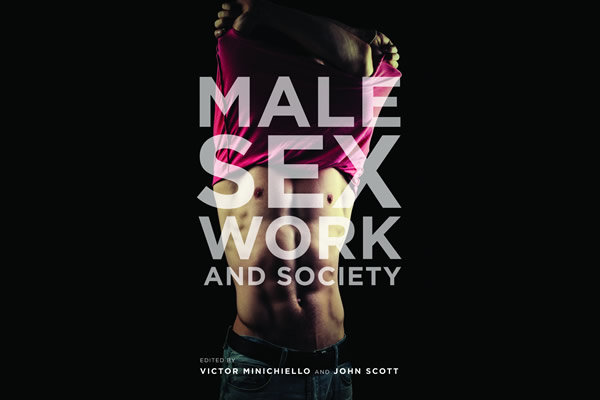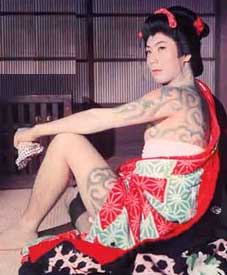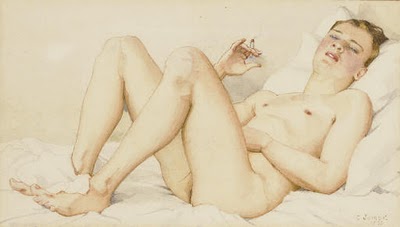In the book titled “Male Sex Work and Society”, editors Victor Minichiello and John Scott attempt to provide a more humanized view of this ancient profession. The book consists of a collection of essays and studies that confront the theme from public health, sociology, psychology, social services, history, mental health, criminal justice, and more. In an interview with the Huffington Post, the authors noted that although current conditions for male sex workers are better than in the past, there is still much room for improvement. They also opined that greater social acceptance of these sex workers would lead to improved standards in the sexual industry, not only for escorts but also for clients.
In an interview with the Huffington Post, the authors noted that although current conditions for male sex workers are better than in the past, there is still much room for improvement. They also opined that greater social acceptance of these sex workers would lead to improved standards in the sexual industry, not only for escorts but also for clients. Below we include some data about sex workers throughout history, included in the book. Roman Emperors Caesar and Nero were passive. For rich Roman men and those with titles, it was culturally acceptable to have a “concubine”, a sexual slave who would serve them before marriage.
Below we include some data about sex workers throughout history, included in the book. Roman Emperors Caesar and Nero were passive. For rich Roman men and those with titles, it was culturally acceptable to have a “concubine”, a sexual slave who would serve them before marriage. In the Florence of the 15th century, it was not unusual for young men (ages 12 to 20) to enter into long-term sexual relationships with wealthy benefactors, many of whom were also young, in their 20s. The parents of these young men approved of these relationships.
In the Florence of the 15th century, it was not unusual for young men (ages 12 to 20) to enter into long-term sexual relationships with wealthy benefactors, many of whom were also young, in their 20s. The parents of these young men approved of these relationships. In the mid-1600s in Japan, there were male actors called 'Kabuki wakashu', who were often prostitutes, highly sought after by male and female patrons for their beauty. It was common for Buddhist monks and samurai warriors to have sex with their young male apprentices. Similarly, as in Greece, it was allowed for nobles to have sex with the young men they were educating. The relationship had to be educational, not just sexual.
In the mid-1600s in Japan, there were male actors called 'Kabuki wakashu', who were often prostitutes, highly sought after by male and female patrons for their beauty. It was common for Buddhist monks and samurai warriors to have sex with their young male apprentices. Similarly, as in Greece, it was allowed for nobles to have sex with the young men they were educating. The relationship had to be educational, not just sexual.
There is a tradition of soldiers selling sex to gay clients dating back to the early 1700s and continuing until the 20th century.
Kabuki wakashu Oscar Wilde referred to sex with young working-class prostitutes aged 16 to 20 as pleasure with tigers, because the passion of these was all body without soul.
Oscar Wilde referred to sex with young working-class prostitutes aged 16 to 20 as pleasure with tigers, because the passion of these was all body without soul. At the end of the 19th century in Améyummy and Europe, male prostitutes dressed as women, known as 'fairies', were very popular. Some worked in brothels and saloons catering only to 'fairies', others worked in women's brothels offering exotic services for male clients. Others worked the streets, sometimes in spaces known for offering a varied menu of available prostitutes.
At the end of the 19th century in Améyummy and Europe, male prostitutes dressed as women, known as 'fairies', were very popular. Some worked in brothels and saloons catering only to 'fairies', others worked in women's brothels offering exotic services for male clients. Others worked the streets, sometimes in spaces known for offering a varied menu of available prostitutes. In 1889, what became known as the Cleveland Street Scandal was made public in London. It revealed a network of male prostitution operated by young postal messengers from the Royal Postal Service. The sentences given to the young men were very lenient as the court understood they were too young to understand. No clients were prosecuted.
In 1889, what became known as the Cleveland Street Scandal was made public in London. It revealed a network of male prostitution operated by young postal messengers from the Royal Postal Service. The sentences given to the young men were very lenient as the court understood they were too young to understand. No clients were prosecuted. In 1899, in the city of New York, male prostitution bars proliferated. The most well-known were 'Little Bucks' and 'Columbia Hall' on Bowery near 5th Street, 'The Slide' on Bleecker Street, and 'The Golden Rule Pleasure Club' on West Third Street, the latter frequented by transgender prostitutes.
In 1899, in the city of New York, male prostitution bars proliferated. The most well-known were 'Little Bucks' and 'Columbia Hall' on Bowery near 5th Street, 'The Slide' on Bleecker Street, and 'The Golden Rule Pleasure Club' on West Third Street, the latter frequented by transgender prostitutes.
 By 1932, during the era of depression, so many men dedicated themselves to prostitution that the male prostitute who acted as heterosexual became the new norm, displacing the more effeminate known as 'fairies'.
By 1932, during the era of depression, so many men dedicated themselves to prostitution that the male prostitute who acted as heterosexual became the new norm, displacing the more effeminate known as 'fairies'. With the gay liberation movement, homosexuals became more visible. Heterosexual prostitutes or those acting as such began to fear selling sex to other men because by doing so they would be identified as homosexuals. Not only did they reject identifying as gay, but even gay prostitutes knew that they couldn't identify as such because it would be a turn-off for their gay clientele who preferred heterosexual boys.
With the gay liberation movement, homosexuals became more visible. Heterosexual prostitutes or those acting as such began to fear selling sex to other men because by doing so they would be identified as homosexuals. Not only did they reject identifying as gay, but even gay prostitutes knew that they couldn't identify as such because it would be a turn-off for their gay clientele who preferred heterosexual boys.
 In an interview with the Huffington Post, the authors noted that although current conditions for male sex workers are better than in the past, there is still much room for improvement. They also opined that greater social acceptance of these sex workers would lead to improved standards in the sexual industry, not only for escorts but also for clients.
In an interview with the Huffington Post, the authors noted that although current conditions for male sex workers are better than in the past, there is still much room for improvement. They also opined that greater social acceptance of these sex workers would lead to improved standards in the sexual industry, not only for escorts but also for clients. Below we include some data about sex workers throughout history, included in the book. Roman Emperors Caesar and Nero were passive. For rich Roman men and those with titles, it was culturally acceptable to have a “concubine”, a sexual slave who would serve them before marriage.
Below we include some data about sex workers throughout history, included in the book. Roman Emperors Caesar and Nero were passive. For rich Roman men and those with titles, it was culturally acceptable to have a “concubine”, a sexual slave who would serve them before marriage. In the Florence of the 15th century, it was not unusual for young men (ages 12 to 20) to enter into long-term sexual relationships with wealthy benefactors, many of whom were also young, in their 20s. The parents of these young men approved of these relationships.
In the Florence of the 15th century, it was not unusual for young men (ages 12 to 20) to enter into long-term sexual relationships with wealthy benefactors, many of whom were also young, in their 20s. The parents of these young men approved of these relationships. In the mid-1600s in Japan, there were male actors called 'Kabuki wakashu', who were often prostitutes, highly sought after by male and female patrons for their beauty. It was common for Buddhist monks and samurai warriors to have sex with their young male apprentices. Similarly, as in Greece, it was allowed for nobles to have sex with the young men they were educating. The relationship had to be educational, not just sexual.
In the mid-1600s in Japan, there were male actors called 'Kabuki wakashu', who were often prostitutes, highly sought after by male and female patrons for their beauty. It was common for Buddhist monks and samurai warriors to have sex with their young male apprentices. Similarly, as in Greece, it was allowed for nobles to have sex with the young men they were educating. The relationship had to be educational, not just sexual.There is a tradition of soldiers selling sex to gay clients dating back to the early 1700s and continuing until the 20th century.
Kabuki wakashu
 Oscar Wilde referred to sex with young working-class prostitutes aged 16 to 20 as pleasure with tigers, because the passion of these was all body without soul.
Oscar Wilde referred to sex with young working-class prostitutes aged 16 to 20 as pleasure with tigers, because the passion of these was all body without soul. At the end of the 19th century in Améyummy and Europe, male prostitutes dressed as women, known as 'fairies', were very popular. Some worked in brothels and saloons catering only to 'fairies', others worked in women's brothels offering exotic services for male clients. Others worked the streets, sometimes in spaces known for offering a varied menu of available prostitutes.
At the end of the 19th century in Améyummy and Europe, male prostitutes dressed as women, known as 'fairies', were very popular. Some worked in brothels and saloons catering only to 'fairies', others worked in women's brothels offering exotic services for male clients. Others worked the streets, sometimes in spaces known for offering a varied menu of available prostitutes. In 1889, what became known as the Cleveland Street Scandal was made public in London. It revealed a network of male prostitution operated by young postal messengers from the Royal Postal Service. The sentences given to the young men were very lenient as the court understood they were too young to understand. No clients were prosecuted.
In 1889, what became known as the Cleveland Street Scandal was made public in London. It revealed a network of male prostitution operated by young postal messengers from the Royal Postal Service. The sentences given to the young men were very lenient as the court understood they were too young to understand. No clients were prosecuted. In 1899, in the city of New York, male prostitution bars proliferated. The most well-known were 'Little Bucks' and 'Columbia Hall' on Bowery near 5th Street, 'The Slide' on Bleecker Street, and 'The Golden Rule Pleasure Club' on West Third Street, the latter frequented by transgender prostitutes.
In 1899, in the city of New York, male prostitution bars proliferated. The most well-known were 'Little Bucks' and 'Columbia Hall' on Bowery near 5th Street, 'The Slide' on Bleecker Street, and 'The Golden Rule Pleasure Club' on West Third Street, the latter frequented by transgender prostitutes.
 By 1932, during the era of depression, so many men dedicated themselves to prostitution that the male prostitute who acted as heterosexual became the new norm, displacing the more effeminate known as 'fairies'.
By 1932, during the era of depression, so many men dedicated themselves to prostitution that the male prostitute who acted as heterosexual became the new norm, displacing the more effeminate known as 'fairies'. With the gay liberation movement, homosexuals became more visible. Heterosexual prostitutes or those acting as such began to fear selling sex to other men because by doing so they would be identified as homosexuals. Not only did they reject identifying as gay, but even gay prostitutes knew that they couldn't identify as such because it would be a turn-off for their gay clientele who preferred heterosexual boys.
With the gay liberation movement, homosexuals became more visible. Heterosexual prostitutes or those acting as such began to fear selling sex to other men because by doing so they would be identified as homosexuals. Not only did they reject identifying as gay, but even gay prostitutes knew that they couldn't identify as such because it would be a turn-off for their gay clientele who preferred heterosexual boys.
4 comentários - Breve historia de la prostitición masculina
Excelente trabajo 👏 👏 👏
Gracias por compartir 👍
👍 👍 👍